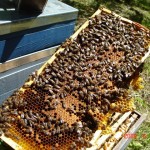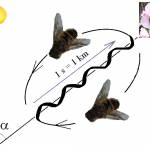 For humans, sleep deprivation has a negative impact on performance in many areas, such as motor and communication skills. In particular, communication impairment is the topic of an article published yesterday in PNASProceedings of the National Academy of Sciences. But the research in this paper isn’t about humans – it’s about honeybees.
For humans, sleep deprivation has a negative impact on performance in many areas, such as motor and communication skills. In particular, communication impairment is the topic of an article published yesterday in PNASProceedings of the National Academy of Sciences. But the research in this paper isn’t about humans – it’s about honeybees.
To begin with… bees sleep? Apparently so. Bees don’t have tiny little eyelids that droop, nor do they snore. Instead, bee sleep is characterized by certain changes in their behavior that can be observed by interested researchers. The bees stop moving, they have a “specific posture” (?), and they become less responsive to disturbances. Most of this sleep happens at night.
So what happens when you don’t let a bee get her beauty sleep? Well, she gets sloppy.
One way that bees communicate with each other is by a dance called a “waggle dance”. They go out foraging for food, and then they come back to the hive and tell the others what they saw through interpretive dance. The dance consists of various waggles and turns in certain sequences and with certain body angles. Precision is important to accurately convey the direction of and distance to food, but sleepy bees get careless with their body angles and thus communicate less effectively.
 How exactly does one go about measuring a bee’s sleep deprivation? Researchers set up a bee hive in a shed and tagged several of the bees with either a tiny piece of steel or a tiny piece of copper. All of these lucky tagged bees were taught to visit a sugar-water feeder about 1 km away from the bee hive. The researchers then used an “insominator” – a rigged-up apparatus consisting primarily of magnets – to disrupt the sleep of the steel-tagged bees at night. This magnetic apparatus swept back and forth across the bee hive; as it passed over bees with steel tags, the attraction between the steel and the magnets tugged or pushed on the bees, giving them a little jolt. The copper-tagged bees served as controls – their tags were unresponsive to the magnets, and so they were able to sleep uninterrupted by the sweeping magnets. All the rest of the untagged bees in the hive were also unaffected by the insominator.
How exactly does one go about measuring a bee’s sleep deprivation? Researchers set up a bee hive in a shed and tagged several of the bees with either a tiny piece of steel or a tiny piece of copper. All of these lucky tagged bees were taught to visit a sugar-water feeder about 1 km away from the bee hive. The researchers then used an “insominator” – a rigged-up apparatus consisting primarily of magnets – to disrupt the sleep of the steel-tagged bees at night. This magnetic apparatus swept back and forth across the bee hive; as it passed over bees with steel tags, the attraction between the steel and the magnets tugged or pushed on the bees, giving them a little jolt. The copper-tagged bees served as controls – their tags were unresponsive to the magnets, and so they were able to sleep uninterrupted by the sweeping magnets. All the rest of the untagged bees in the hive were also unaffected by the insominator.

Bee Hoverfly Waggle Dance (Wikimedia Commons) see link in comments for diagram of actual honey bee dance
The next morning, following a night of tossing-and-turning (for the steel-tagged bees at least), the bees went out foraging as usual. As usual, they returned to the hive later and reported their findings by waggle dancing. The dance of the copper-tagged bees looked the same as ever, but the dance of the steel-tagged bees was a bit messier. They did the right sequences of turns and pauses and waggles, but they didn’t do their body angles very well. Apparently, body angles convey information about direction (north, south, etc.), so faulty body angles could send the other bees off on the wrong path.
This seems to be the first study ever to look at how sleep deprivation affects communication by non-humans. I’d like to see more studies like this – maybe whale songs would be off-key when they’re behind on their sleep? Or tired parrots might slur their speech when asking for a cracker?
Citation:
Barrett A. Klein, Arno Klein, Margaret K. Wray, Ulrich G. Mueller, Thomas D. Seeley (2010). Sleep deprivation impairs precision of waggle dance signaling in honey bees Proceedings of the National Academy of Sciences : 10.1073/pnas.1009439108


Note that the waggle dance figure (likely borrowed from Wikipedia) features syrphid hover flies and NOT honey bees!
Thanks for the catch! And for the cool research! Here’s the link to the poster on pupating.org for the accurate dance pattern for honey bees.
Lack of z’s
Affects the bees
Up in the trees
So when it’s late
‘Twould be great
To be quiet, please.
I like it Eric! For some reason I feel like this would work well as a song for Pooh Bear to sing.
I love the idea of hover flies performing waggle dances. This in itself would be a biology show-stopper. Thanks for making the correction. I will get around to posting up a replacement image on Wikipedia at some point…
cheers,
barrett
This comment is not authoritative, since I’m mobile and can cite no references, but two thoughts on the bee article: on a tv documentary on bees, it was mentioned that all the worker bees in the hive being shown were female (irrelevant to this, yes) and that they “did not sleep for 31 days, after which they slept forever.” So- unless the commentary was referring to a different bee occupation, stay-at-hive bees which never navigated outside the hive…it seemed to be saying that bees do not sleep.
Which leads to the second thought: how do the researchers know that the sloppy waggling was due to lack of presumed sleep and not due to extra stress and strain on the tiny muscles of the tiny bees when they were doing something other than sleeping, such as singing, praying, meditating, or whatever a bee might do while it is physically still yet 100% wide awake? Perhaps I’ve read too many sci-fi stories and watched too many episodes of Star Trek etc, not to forget, also, the mice in Hitchhiker’s Guide to the Galaxy…but it seems narrow minded to assume the bees were sleeping and there are no other possibilities.
I’m not sure about the tv documentary; I guess that bee sleep researchers would disagree with the statement that bees don’t sleep. This article cites several previous references documenting why it’s believed that bees sleep. The bees have an “increased threshold of response to disturbance”, much as a person would be oblivious to very quiet sounds or other mild stimuli while he/she is asleep. The bees also have “discontinuous ventilation” (their “breathing” pattern changes), and their antennae stop moving around.
You bring up a good point though – you can’t really prove anything in science. Science is based on formulating reasonable hypotheses and examining the evidence that supports or contradicts said hypotheses. It would certainly be difficult to “prove” that this bee behavior is correctly identified as sleep and not something else. But sleeping seems to be a reasonable and well-supported explanation for this behavior. You would probably agree that a bee seems more likely to sleep than to meditate. (If bees pray and meditate, now that would be quite the discovery!)
I put the question into a Google query, “do bees sleep?” and found the same question in a FAQ on the British Beekeepers’s website http://www.britishbee.org.uk/faq.php
The answer on the website, is “No, but during the night most bees remain motionless reserving their energies for the next day. ”
Which poses the question: How can the British Beekeepers or the other researchers tell the difference between bees that are conscious but remaining motionless to conserve their energies and bees that are asleep and likewise motionless?
Another possible explanation for the “sloppy waggling,” might be that the iron carried by the sloppy waggling bees, since it is affected by magnetic fields such as that of the earth and any electro-magnetic fields in the vicinity of the area between their hive and the flowers they visit, would add a factor of extra sloppiness to their flight paths which would not be present if they were flying without the bits of iron attached.